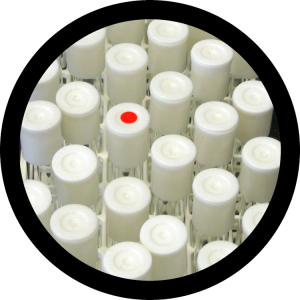Natural Product Discovery
 Unlocking the Bacterial Repertoire
Unlocking the Bacterial Repertoire
Bacteria produce the majority of our antibiotics, as well as many of our anticancer drugs and other therapeutics. While a boon to human health, to bacteria these secondary metabolites are a significant drain on resources, with no guaranteed fitness advantage. To ensure that these metabolites are only produced when needed, bacteria have developed complex regulatory networks that limit translation of the enzymes which synthesize each metabolite.
The recent advent of inexpensive genomic sequencing has allowed us to search for metabolite biosynthetic genes en mass. Surprisingly, even our most productive bacterial strains use only about 10% of their biosynthetic machinery when cultured in the lab. The rest of the genes are never activated, potentially hiding new drugs in plain view.
In the Findlay lab we aim to understand secondary metabolite regulation, learning how to trigger these “cryptic” biosynthetic genes and characterize the natural products they produce. At the same time we seek to understand the ecological role of these compounds, as outlined in this recent review from the lab.
Out-Smarting Antibiotic Resistance
The discovery of antibiotics changed the face of medicine, offering a means of treating even the most severe bacterial infection and making complex, invasive therapies possible. However, the rise of antibiotic resistance threatens to end the antibiotic era. Much of our repertoire is now ineffective against the majority of infections they originally treated, and patients in North America have begun dying from infections that are resistant to every drug in our arsenal.
To combat these new pathogens we need to discover new antibiotics (see Natural Product Discovery, above). However, introducing new antibiotics to the clinic will not be enough to ensure that we have effective drugs in the years to come. Unless we improve our understanding of how antibiotic resistance emerges, these new drugs will soon become just as obsolete as our current cadre. To tackle antibiotic resistance we must better understand how antibiotic-resistant bacteria emerge and come to dominate in clinical settings. With that knowledge will be able to design better treatment plans, safeguarding drugs both old and new.
In the Findlay lab we are working to tackle the evolutionary processes that lead to antibiotic resistance, using directed evolution to develop antibiotic resistance in laboratory and pathogenic bacteria. As part of this we have developed SAGE, a Soft Agar Gradient Evolution system. SAGE was recently used to study the kinetics of antibiotic resistance evolution, as described in this publication in Scientific Reports. (pdf)
Directed Bacterial Evolution
Bacteria and their products surround us, from the vanilla flavour of our ice cream to the insulin in our pharmacies to the suds that clean our clothes.
None of these things are naturally made by bacteria, but we have tweaked enzymes, added genes from other organisms, and rearranged entire metabolic pathways to create the strains we need.
However, we are ultimately limited by our source material, and there is a growing need for strains more resistant to industrial conditions, flexible in their feedstocks, and able to produce compounds not found in nature.
In the Findlay lab we start with known bacterial strains, then use selective pressure to jump-start evolution. Early work will focus on producing robust strains, en route to the development of molecular factories.
Interested in biochemistry? Send a copy of your CV, transcript and statement of research interests to Brandon.Findlay@Concordia.ca, visit the department’s webpage, or apply directly to Concordia University.
